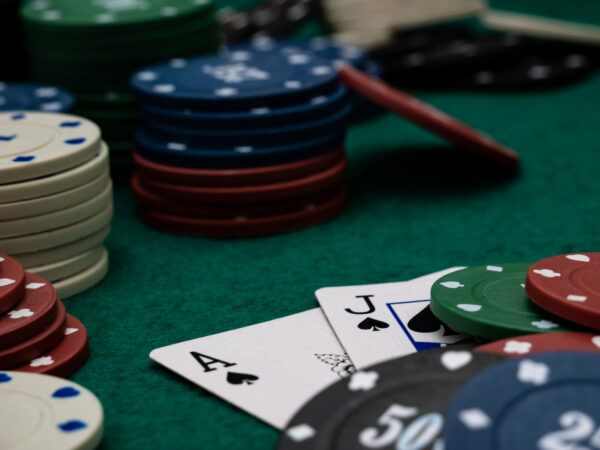What is single-deck blackjack?
Are you new to blackjack? Maybe you’re just looking for a refresher. We’re here to tell you all about single-deck blackjack and why it might be the deck choice for you! And if anyone knows about different blackjack formats, it’s us. Many of our players prefer blackjack to any other game, and we aim to please by offering the latest, most popular evolutions of the game. You might even say we’re something of a connoisseur.
Are you ready to learn more about blackjack single-deck strategy? Let’s take a closer look at what the game has to offer.
Single-deck blackjack rules
Before we go in-depth about blackjack single-deck strategy, we will go over the basics.
The main objective of single-deck blackjack is the same as most versions of the game. Players need to reach 21 without going over (or “going bust”). The rules for single-deck blackjack and multi-deck blackjack are essentially the same and look like this:
- Two cards each are dealt to the dealer and the players
- One of the dealer’s cards faces up while the other faces down
- Your goal is to beat the dealer and have the deck closest to 21 without going bust
- You can ask for additional cards (also known as asking for a “hit”) on your turn, but be careful – if you go over 21, you’re out of the game
That’s it! The basic rules are pretty simple. Just remember that dealers can use house rules, which can change things significantly. Make sure you understand how the table works before you commit.
Single vs. multiple-deck blackjack
Single and multiple-deck blackjack are very similar and boast the same goal. No matter how many decks are in play, the overall goal is to reach 21 without going bust. Here are some additional differences to keep in mind.
Single-deck games are played with one 52-card deck, while multi-deck games consist of four, six or eight of them. The theoretical house edge on single-deck blackjack is 0.15% compared to 0.46% through 0.65% when playing multi-deck games. This isn’t the whole story, however, and we explain more about that in the next section.
Payout options are another difference to keep in mind. Multi-deck blackjack often pays out 3:2, while single-deck often pays out 6:5. This boosts the house edge on single-deck games and lowers it on multi-deck games.
Blackjack single-deck games typically have more double-down options because there are fewer 10♠ cards. This, in turn, lowers the chance of going bust.
If all other rules are equal, blackjack single-deck offers a lower house edge than multi-deck. In practice, however, multi-deck often boasts better odds thanks to rules such as:
- Dealer hits on a soft 17
- Double downs are restricted
- Splitting pairs are limited to one or two times
Sometimes single and multi-deck blackjack games are equal, sometimes single-deck has the upper hand and sometimes multi-decks can offer the most impressive returns.
Something else to remember is that beyond the issues discussed above, single and multi-deck blackjack games have other advantages. Single-deck games make it easier to keep track of the cards in play. This makes predicting the next card a bit easier and could be the difference between a risky hit and an early fold.
Multi-deck blackjack games make it much more difficult to track cards but sometimes easier to double down. The house edge on insurance bets is often better with multi-deck games, too. In addition, single-deck blackjack odds might not be as high as multi-deck games.
How to play single-deck blackjack?
Playing single-deck blackjack is just as easy (or hard) as playing any other variant of blackjack. It is the “classic” version of the game as well. If you are new to the game but have a vague idea of how it is played, chances are good that you are thinking of single-deck blackjack.
There are a few rules to keep in mind as you play single-deck blackjack. First, every card dealt dramatically affects the distribution of any remaining cards still in the deck. Tracking cards (more on that later) can be a serious advantage, which allows you to estimate what other players have in their hands as well as what cards you might receive if you hit.
Surrender only if it is the best choice. This should be a strategic decision, not something you do on a whim. If the dealer has a 10 but you have a pair of sevens, the odds are against you. Surrendering here is reasonable.
You can split your hand up to three times. Expect the dealer to hit on a soft 17. You can split aces and receive one card each, but these cards cannot be split further. If your hand consists of a 10-value card and a split ace, the total is not a blackjack! Keep this in mind as you decide how to play your cards.
Single-deck blackjack card counting
Some people think that card counting in blackjack is illegal, but that is not true. This legal technique is used by players to make informed decisions about what remains in the deck and what is likely at play. Players who count cards can potentially turn the odds in their favor as the game progresses.
Something to keep in mind here is that while card counting is not illegal, it is not always welcomed at casinos. This is one of the reasons single-deck games are disappearing from casinos around the world.
Single-deck strategy
Blackjack single-deck strategy is easier than it might seem. Here are some tips to help you make the right choice at the optimal time when playing.
Understanding when to hit and when to stand is one of the most important strategies to master when playing single-deck blackjack. You should hit on most pairs of cards. Exceptions include pairs of eights, nines or 10s, in any combination.
Doubling is another element of successful blackjack play. There are many situations you can double, but it is most commonly done when you have soft hands combined with the dealer showing a 4-6, 3-6, 2-6 or a six. Try to stand only on hands of 17 to 21. Sometimes this isn’t possible, but do your best to hit until you get there and then stand for the rest of the game.
What do you think about single-deck blackjack? We hope our article has helped you understand the basics as well as the pros and cons between single and multi-deck games. If you’re a beginner and to become more familiar with blackjack strategy, you may want to read basic blackjack strategy or hand gestures in Blackjack.




